Yakuts
The Yakuts, or the Sakha (Yakut: саха, sakha, plural: сахалар, sakhalar), are a Turkic ethnic group who mainly live in the Republic of Sakha in the Russian Federation, with some extending to the Amur, Magadan, Sakhalin regions, and the Taymyr and Evenk Autonomous Districts. The Yakut language belongs to the Siberian branch of the Turkic languages. The Russian word yakut was taken from Evenk yokō. The Yakuts call themselves sakha or urangai sakha in some old chronicles.[6]
Саха | |
|---|---|
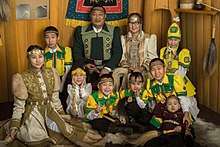 A Yakut family | |
| Total population | |
| 500,000 | |
| Regions with significant populations | |
| 478,085 (2010 census)[1] | |
| 17,454 (1999–2007 census) | |
| 4,257 (2017 census)[2] | |
| 415 (2009 census)[3][4] | |
| 304 (2001 census)[5] | |
| Languages | |
| Yakut, Russian | |
| Religion | |
| Shamanism, Eastern Orthodoxy | |
| Related ethnic groups | |
| Dolgans, Tuvans, Khakas, Altay, Mongols | |

Culture
The Yakuts engage in animal husbandry, traditionally having focused on rearing horses, mainly the Yakutian horse, reindeer and the Sakha Ynagha (Yakutian cow), a hardy kind of cattle known as Yakutian cattle which is well-adapted to the harsh local weather.[7][8]
Certain rock formations named Kigilyakh, as well as places such as Ynnakh Mountain, are held in high esteem by Yakuts.[9]
Origin and history
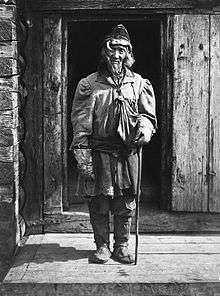
The ancestors of Yakuts were Kurykans who migrated from Yenisey river to Lake Baikal and were subject to a certain Mongolian admixture prior to migration[10][11][12] in the 7th century. The Yakuts originally lived around Olkhon and the region of Lake Baikal. Beginning in the 13th century they migrated to the basins of the Middle Lena, the Aldan and Vilyuy rivers under the pressure of the rising Mongols. The northern Yakuts were largely hunters, fishermen and reindeer herders, while the southern Yakuts raised cattle and horses.[13][14]
In the 1620s the Tsardom of Muscovy began to move into their territory and annexed or settled down on it, imposed a fur tax and managed to suppress several Yakut rebellions between 1634 and 1642. The tsarist brutality in collection of the pelt tax (yasak) sparked a rebellion and aggression among the Yakuts and also Tungusic-speaking tribes along the River Lena in 1642. The voivode Peter Golovin, leader of the tsarist forces, responded with a reign of terror: native settlements were torched and hundreds of people were killed. The Yakut population alone is estimated to have fallen by 70 percent between 1642 and 1682, mainly because of smallpox and other infectious diseases.[15][16]
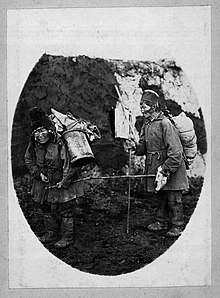
In the 18th century the Russians reduced the pressure, gave Yakut chiefs some privileges, granted freedom for all habitats, gave them all their lands, sent Eastern Orthodox missions, and educated the Yakut people regarding agriculture. The discovery of gold and, later, the building of the Trans-Siberian Railway, brought ever-increasing numbers of Russians into the region. By the 1820s almost all the Yakuts claimed to have converted to the Russian Orthodox church, but they retained (and still retain) a number of shamanist practices. Yakut literature began to rise in the late 19th century, and a national revival occurred in the early 20th century.
In 1922, the new Soviet government named the area the Yakut Autonomous Soviet Socialist Republic. The last conflict of the Russian Civil War, known as the Yakut Revolt, occurred here when Cornet Mikhail Korobeinikov, a White Russian officer, led an uprising and a last stand against the Red Army.
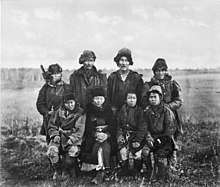
In the late 1920s through the late 1930s, Yakut people were systematically persecuted, when Joseph Stalin launched his collectivization campaign.[17] It is possible that hunger and malnutrition during this period resulted in a decline in the Yakut total population from 240,500 in 1926 to 236,700 in 1959. By 1972, the population began to recover.[18]

The majority of Yakut males belong to Haplogroup N-Tat, with the observed frequency in most samples of Yakuts being approximately 90% (Central Yakut 86%,[19] Yakut 89%,[20] Vilyuy Yakut 93%,[19] Yakut 94%[21]). However, a sample of Yakut males from northern Yakutia has revealed a somewhat lower frequency of this haplogroup (Northern Yakut 47/66 = 71% N-TAT).[19] The remainder of the Yakut Y-DNA pool consists of members of haplogroup C-M217 (approximately 4.0%, including members of the C-M48 and C-M407 subclades), haplogroup R1a-M17 (approximately 3.5%, including members of the R1a-M458 subclade), and haplogroup N-P43 (approximately 2.1%), with sporadic instances of haplogroup I1-M253, haplogroup R1b-M269, haplogroup J2, and haplogroup Q.[21][19]
A majority of Yakut people belong to mtDNA haplogroup C (75/164 = 45.7% Central Yakut,[19] 60/148 = 40.5% Northern Yakut,[19] 40/111 = 36.0% Vilyuy Yakut[19]) or haplogroup D (54/164 = 32.9% Central Yakut,[19] 33/111 = 29.7% Vilyuy Yakut,[19] 38/148 = 25.7% Northern Yakut[19]), with subclades D5a2a2 (57/423 = 13.48%[19]), C4a1c (47/423 = 11.11%[19]), C4a2 (35/423 = 8.27%[19]), C4b1 (33/423 = 7.80%[19]), and C5b1b (19/423 = 4.49%[19]) being particularly well represented. Minor mtDNA haplogroups of Eastern Eurasian origin include haplogroup G (22/423 = 5.20%,[19] including 19/423 = 4.49% G2a and 3/423 = 0.71% G1b), haplogroup F (19/423 = 4.49%,[19] including 13/423 = 3.07% F1b and 6/423 = 1.42% F2b1), haplogroup M13a1b (15/423 = 3.55%[19]), haplogroup A (8/423 = 1.89%[19]), haplogroup Y1a (5/423 = 1.18%[19]), haplogroup B (5/423 = 1.18%[19]), haplogroup Z3 (4/423 = 0.95%[19]), and haplogroup M7 (3/423 = 0.71%[19]). A minority of Yakuts (42/423 = 9.93%[19]) belong to mtDNA haplogroups of Western Eurasian origin, including haplogroup H (15/423 = 3.55%[19]), haplogroup W (6/423 = 1.42%[19]), haplogroup J1c5 (6/423 = 1.42%[19]), haplogroup T2 (5/423 = 1.18%[19]), haplogroup HV1a1a (5/423 = 1.18%[19]), haplogroup R1b2a (2/423 = 0.47%[19]), haplogroup U5b1b1a (2/423 = 0.47%[19]), and haplogroup U4d2 (1/423 = 0.24%[19]).
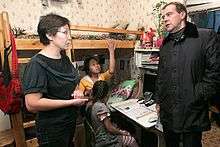
Currently, Yakuts form a large plurality of the total population within the vast Sakha Republic. According to the 2010 Russian census, there were a total of 466,492 Yakuts residing in the Sakha Republic during that year, or 49.9% of the total population of the Republic.
Language
According to the 2010 census, some 87% of the Yakuts in the Sakha Republic are fluent in the Yakut (or Sakha) language, while 90% are fluent in Russian.[22] The Sakha/Yakut language belongs to the North Siberian of the Siberian Turkic languages. It is most closely related to the Dolgan language, and also to a lesser extent related to Tuvan and Shor.
Cuisine
The cuisine of Sakha prominently features the traditional drink kumis, dairy products of cow, mare, and reindeer milk, sliced frozen salted fish stroganina (строганина), loaf meat dishes (oyogos), venison, frozen fish, thick pancakes, and salamat—a millet porridge with butter and horse fat. Kuerchekh [Куэрчэх] or kierchekh, a popular dessert, is made of cow milk or cream with various berries. Indigirka is a traditional fish salad. This cuisine is only used in Yakutia.
See also
- Aisyt (Ajysyt/Ajyhyt), the name of the mythic mother goddess of the Sakha people
- Music in the Sakha Republic
- Turkic people
- Yakutia
- Yakut language
References
- "ВПН-2010". Retrieved 18 March 2015.
- http://www.gks.ru/fre.co. Missing or empty
|title=(help) - "Қазақстан 2009 жылы". Archived from the original on 15 February 2017. Retrieved 18 March 2015.
- Агентство Республики Казахстан по статистике. Перепись 2009. Archived 2013-08-10 at the Wayback Machine (Национальный состав населения Archived 2011-07-23 at the Wayback Machine.rar)
- Всеукраїнський перепис населення 2001. Русская версия. Результаты. Национальность и родной язык. Archived 2010-07-01 at the Wayback Machine
- Inside the New Russia (1994): Yakuts
- "The Yakutian cattle: A cow of the permafrost" (PDF). Archived from the original (PDF) on 2020-03-10. Retrieved 2020-01-26.
- Meerson, F. "Survival".
- Murzin Yuri Andreyevich, Kigilyakhi of Yakutia
- V.A. Stepanov "Origin of Sakha: Analysis of Y-chromosome Haplotypes" Molecular Biology, 2008, Volume 42, No 2, pp. 226–237, 2008.
- Atlas of Languages of Intercultural Communication in the Pacific, Asia, and the Americas: Vol I: Maps. Vol II: Texts. Walter de Gruyter. 2011. p. 972. ISBN 3110819724.
- Loanwords in the World's Languages: A Comparative Handbook. Walter de Gruyter. 2009. p. 497. ISBN 3110218445.
- И. С. Гурвич., ed. (1956), Народы Сибири
- И. С. Гурвич., ed. (1963), История Якутской АССР
- Richards, John F. (2003). The Unending Frontier: An Environmental History of the Early Modern World. University of California Press. p. 538. ISBN 0520939352.
- Mark Levene; Penny Roberts, eds. (1999), The massacre in history, p. 155
- Book of Peoples of the World: A Guide to Cultures, ed. by Davis, Harrison, Howe, National Geographic Books, ç2008, p.141
- Lewis, Martin (14 May 2012). "The Yakut Under Soviet Rule". GeoCurrents. Retrieved 4 October 2014.
- Sardana A Fedorova, Maere Reidla, Ene Metspalu, et al., "Autosomal and uniparental portraits of the native populations of Sakha (Yakutia): implications for the peopling of Northeast Eurasia." BMC Evolutionary Biology 2013, 13:127. http://www.biomedcentral.com/1471-2148/13/127
- Khar'kov VN, Stepanov VA, Medvedev OF, Spiridonova MG, Maksimova NR, Nogovitsyna AN, Puzyrev VP (2008). "[The origin of Yakuts: analysis of Y-chromosome haplotypes]". Molekuliarnaia Biologiia (in Russian). 42 (2): 226–37. PMID 18610830.
- Duggan AT, Whitten M, Wiebe V, Crawford M, Butthof A, et al. (2013), "Investigating the Prehistory of Tungusic Peoples of Siberia and the Amur-Ussuri Region with Complete mtDNA Genome Sequences and Y-chromosomal Markers." PLoS ONE 8(12): e83570. doi:10.1371/journal.pone.0083570
- http://www.gks.ru/free_doc/new_site/perepis2010/croc/Documents/Vol4/pub-04-07.pdf
